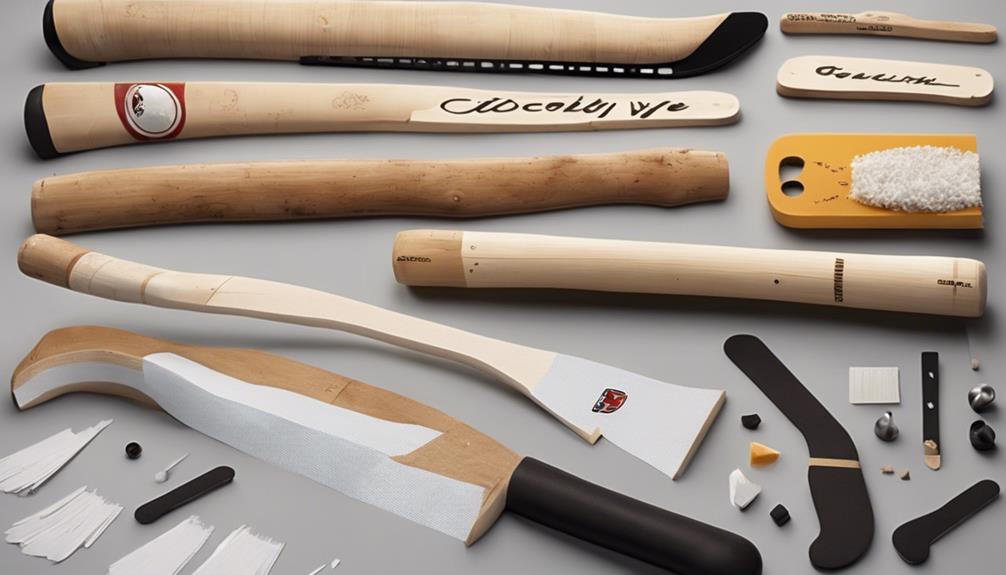The process of creating ice hockey sticks involves a meticulous series of steps that combine craftsmanship and cutting-edge technology. From selecting the materials to fine-tuning the finishing touches, each stage plays a crucial role in shaping the final product.
Understanding the intricate construction methods, from the shaft to the blade, offers a fascinating glimpse into the world of manufacturing these essential tools of the game. Join us as we explore the intricate process behind the creation of ice hockey sticks and uncover the secrets that lie within each carefully crafted piece of equipment.
Materials Used in Ice Hockey Sticks
Ice hockey sticks are primarily constructed using a combination of high-quality materials such as carbon fiber, fiberglass, and composite materials. The blades of these sticks are usually made from materials like carbon fiber or a blend of carbon and fiberglass, providing a balance between stiffness and responsiveness. Blade materials directly impact factors such as accuracy and puck control.
Flex ratings indicate the amount of bend the stick has when force is applied, influencing the power behind shots. Stick weight is crucial, as lighter sticks can enhance stickhandling and quick release. Durability is essential, and composite materials are favored for their strength and ability to withstand the rigors of gameplay, ensuring a longer-lasting stick for players.
Shaft Construction Process
The shaft construction process of ice hockey sticks involves precise techniques to ensure optimal performance and durability. Manufacturers carefully consider weight distribution to achieve the desired balance between strength and flexibility.
Advanced materials such as carbon fiber and fiberglass are commonly used to enhance the stick's overall performance. Additionally, grip technology plays a crucial role in improving player control and handling.
Companies employ innovative textures and materials on the shaft to provide players with a secure and comfortable grip during gameplay. By incorporating these elements into the shaft construction process, ice hockey sticks are designed to meet the high demands of the sport while offering players the performance and durability needed to excel on the ice.
Blade Manufacturing Techniques
Manufacturers employ precision engineering and advanced materials in blade manufacturing techniques to enhance the performance and durability of ice hockey sticks. Blade design plays a crucial role in the stick's overall functionality, with manufacturers utilizing various materials such as carbon fiber, fiberglass, and composite blends to achieve the desired characteristics.
The manufacturing process involves molding the blade, incorporating specific player preferences and customization options. Different blade patterns, curves, and toe designs cater to individual player styles, ensuring optimal performance on the ice.
Understanding Flex and Kick Points
Blade design intricacies directly impact the flex and kick points of ice hockey sticks, crucial factors that significantly influence player performance and shot power. Flexibility analysis plays a key role in determining how much a stick will bend during shooting.
The kick point, where the stick flexes the most, affects the speed and accuracy of shots. Understanding these dynamics is essential for players to optimize their shooting techniques.
Different flex and kick point configurations cater to varying styles of play, allowing players to choose sticks that align with their strengths and preferences. By fine-tuning these aspects, players can enhance their performance on the ice, delivering powerful and precise shots with every play.
Stick Painting and Finishing Touches
During the stick painting and finishing process, intricate layers of specialized coatings are meticulously applied to enhance the durability and aesthetics of ice hockey sticks. Color customization plays a vital role in meeting players' preferences and team branding requirements. High-quality paints and finishes are utilized to ensure the longevity of the design despite the rough handling the sticks may endure during games.
Graphic design elements are carefully incorporated to reflect team logos, player numbers, or sponsor branding, adding a personalized touch to each stick. The branding process not only involves applying logos but also includes protective coatings to safeguard the design from scratches and wear. This meticulous attention to detail ensures that the finished ice hockey sticks not only perform exceptionally but also look visually appealing on the ice.
Quality Control and Testing Procedures
After the stick painting and finishing process, ice hockey sticks undergo rigorous quality control and testing procedures to ensure consistency, performance, and durability meet industry standards.
Performance analysis involves assessing factors like flexibility, weight distribution, and impact resistance to guarantee optimal playability.
Durability testing includes subjecting the sticks to simulated game conditions, such as high-speed impacts and repeated stress, to determine their resilience over time.
Additionally, quality control measures involve checking for defects in materials, construction, and finish to maintain a high level of product excellence.
Frequently Asked Questions
How Do Manufacturers Determine the Optimal Length and Curve of an Ice Hockey Stick for Different Player Positions?
Manufacturers determine the optimal length and curve of ice hockey sticks for different player positions by considering blade curvature for accuracy, stick flex for power, grip texture for control, and weight distribution for balance. These factors are crucial for player performance.
What Are Some Common Differences in the Design and Construction of Ice Hockey Sticks for Youth Players Versus Adult Players?
In designing ice hockey sticks for youth versus adult players, material selection is crucial for weight distribution, flexibility, and grip options. Manufacturers adjust these factors to optimize performance, considering the physical differences and skill levels of each demographic.
Are There Any Environmentally-Friendly Materials or Manufacturing Processes Being Used in the Production of Ice Hockey Sticks?
Sustainable materials and eco-friendly processes are gaining traction in ice hockey stick production, aiming to reduce the carbon footprint. Manufacturers are exploring green alternatives like recycled materials and energy-efficient manufacturing methods to align with environmental consciousness and industry sustainability goals.
How Do Advancements in Technology Impact the Design and Performance of Ice Hockey Sticks?
Technological advancements in ice hockey stick design leverage impactful materials and innovative manufacturing techniques to optimize performance. Enhanced materials like carbon fiber and advanced composites, along with precision engineering, contribute to superior durability and playability.
Can Players Request Customizations or Personalizations to Their Ice Hockey Sticks, and if So, What Are Some Common Options Available?
Players can request customizations for ice hockey sticks. Common options include custom grip choices for enhanced feel and performance, artistic designs for a personalized touch, and personalization like team logos or player names for a unique look.









